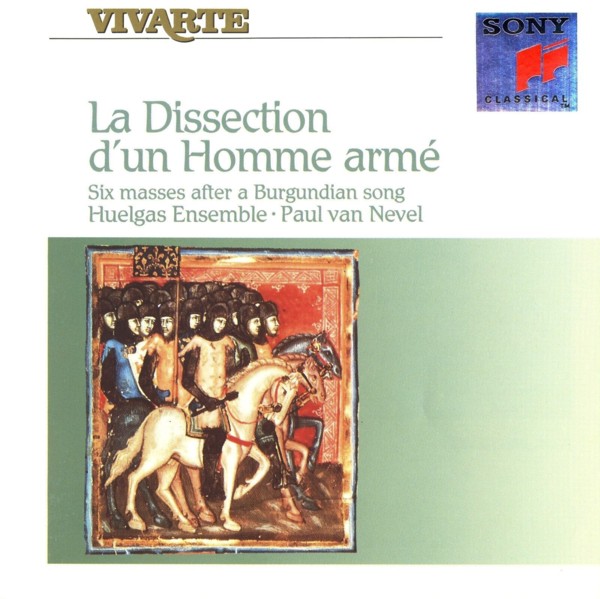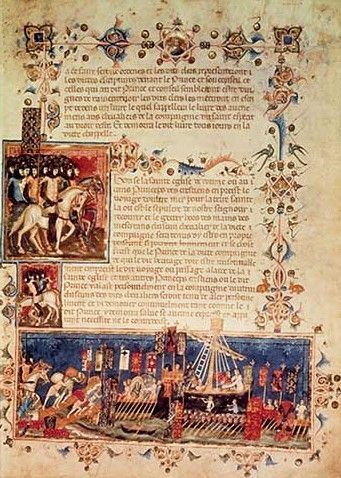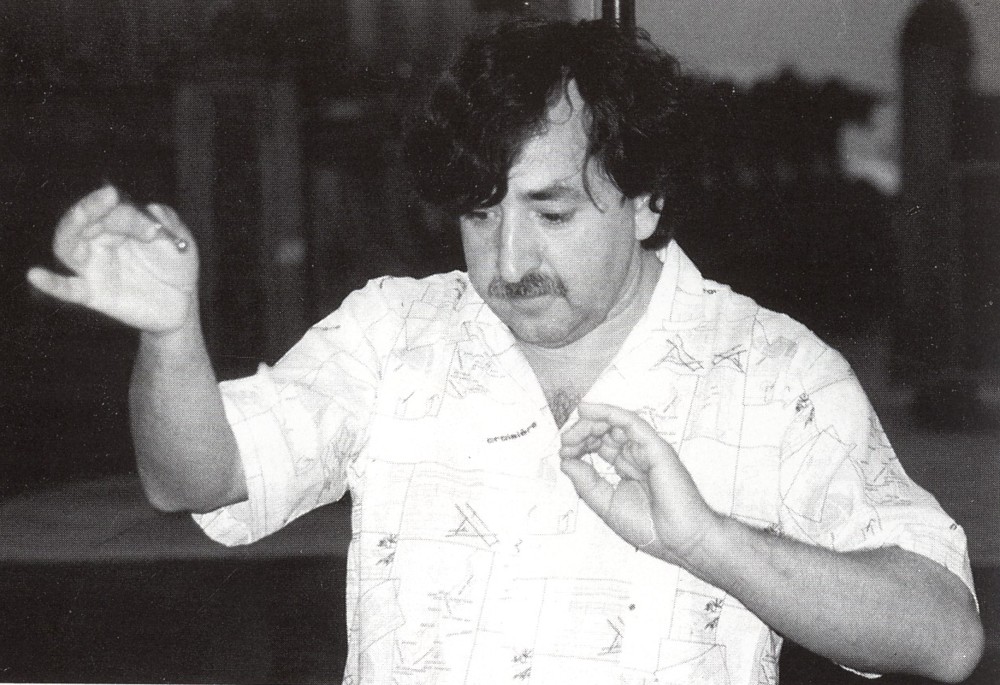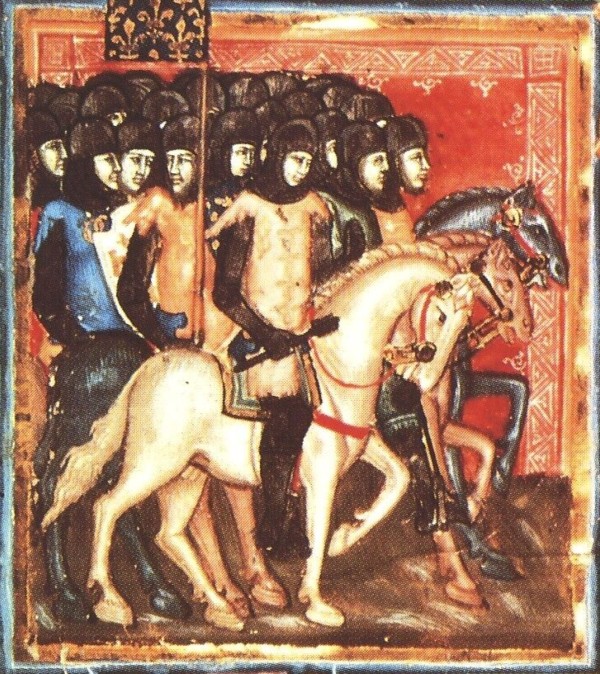
medieval.org
Sony Vivarte 45860
1990

medieval.org
Sony Vivarte 45860
1990
MASS I - SANCTUS
Cantus firmus: Motive A
01 - Sanctus
[2:33]
02 - Pleni sunt caeli [1:27]
03 - Osanna [1:34]
04 - Benedictus [1:41]
05 - Osanna [1:28]
Motivic development:
a. Step-wise development of the original motives up to the fourth above
b. Retrograde of a.
MASS II - CREDO
Cantus firmus: Motive B
06 - Patrem
omnipotentem [4:06]
07 - Crucifixus [3:41]
08 - Et unam sanctam [1:31]
Motivic development:
a. Motive in the original form
b. Retrograde and inversion of a.
c. Inversion of a. (= Retrograde of b.)
d. Retrograde of a. (= Inversion of b.) (= Inversion and Retrograde of
c.)
MASS III - KYRIE
Cantus firmus: Motive C
09 - Kyrie summe
Pater [2:49]
10 - Christe timende Deus [2:02]
11 - Kyrie vivificum [1:17]
Motivic development:
a. Motive in the original form
b. Retrograde of a.
c. Transposition of a. to the fourth above
d. Retrograde of c. (= Transposition of b. to the fifth below)
e. Transposition of a. to the second above (= Transposition of c. to
the fifth below)

MASS IV - SANCTUS
Cantus firmus: Motive D
12 - Sanctus
[2:46]
13 - Pleni sunt caeli [2:04]
14 - Osanna [1:25]
15 - Benedictus [1:38]
16 - Osanna [1:26]
Motivic development:
a. Motive in the original form
b. Retrograde of a.
c. Transposition of a. to the fourth below
d. Retrograde of c. (= Transposition of b. to the fourth below)
MASS V - CREDO
Cantus firmus: Motive E
17 - Patrem
omnipotentem [3:05]
18 - Crucifixus [1:51]
19 - Confiteor [1:33]
AGNUS DEI
20 - Agnus Dei I
[3:26]
21 - Agnus Dei II [1:47]
22 - Agnus Dei III [3:27]
Motivic development:
a. Motive in the original form
b. Retrograde of a. in the fifth below
c. Transposition of a. to the fifth below (= Retrograde of b.)
d. Retrograde of a. (= Transposition of b. to the fifth above) (=
Retrograde of c. in the fifth above)
MASS VI - CREDO
Cantus firmus: L'homme armé complete in the original form
23 - Patrem
omnipotentem [3:38]
24 - Crucifixus [4:08]
25 - Confiteor [2:18]
Thematic development:
Canonic treatment in the fifth below
Huelgas Ensemble
Paul van Nevel
Anne Mertens, cantus
Marie-ClaudeVallin, cantus
Katelijne van Laethem, cantus
Hans Latour, countertenor altus
Josep Cabré, countertenor bassus
Bart Coen, soprano, alto and bass (C, F) recorders
Peter de Clerq, tenor (C) and Bass (F) recorders
René van Laeken, fiddle, rebec, tenor bombardon, tenor dulcian
Symen van MeEchelen, alto sackbut
Sabine Weill, shawm
Schola:
Jean-Yves Guerry, Katelijne van Laethem, Anne Mertens, Nelen Minten,
Marie-ClaudeVallin, Godfried van de Vyvere
recorded: October 1989
Chapel of the Irish College, Leuven

LA DISSECTION D'UN HOMME ARMÉ
The Biblioteca Nazionale in Naples possesses one of the most
remarkable manuscripts of the early Renaissance. The manuscript
catalogued VI E 40 contains a cycle of six masses, all based on the
Burgundian song "L'homme armé", which was very popular in
both the musical and political circles of its day. Each mass contains
the five sections of the Ordinary of the Mass (Kyrie, Gloria, Credo,
Sanctus and Agnus Dei), bringing the total of movements in the entire
compositional cycle to thirty.
The first five masses are written in four parts; the sixth, however, is
composed for five parts, due to the presentation of the cantus
firmus as a two-voiced canon. All the masses contain short passages
for two or three parts without cantus firmus, as well. That is
the case in some middle sections, for example, in the second Agnus Dei
invocation or in the Benedictus. Moreover, all the Kyrie sections are
troped.
This repertoire is unique for a number of reasons. The entire
compositional cycle is grouped around a central theme: the song "L'homme
armé". There exists no other music manuscript that
demonstrates a musical cohesion drawn from one single idea in this way.
For this reason, the Burgundian manuscript with its cycle of thirty
movements is to be considered a unified musical entity. This unity is
emphasized in the outward appearance of the manuscript, as well. Text
and music are presented uniformly in the entire manuscript; so, for
example, throughout the thirty movements of the cycle, those sections
without a cantus firmus are all written in red ink; those
sections with a cantus firmus all appear in black ink. Here the
red color does not, as is otherwise customary, have a specifically
rhythmic significance (as a color), but merely serves to mark
the difference between those passages lacking a cantus firmus
and those containing one. This method of writing is pursued so
consistently, that one note belonging to a cantus firmus
section is written in black ink, while the dot after the note (punctus
additionis) is written in red, when the note is to be held longer
than the last note of the cantus firmus.
Another distinctive feature of this cycle is the diversity and high
quality of the contrapuntal writing. Although the compositions were
handed down anonymously, the influence of two composers is easily and
clearly discernible: of Dufay and above all, of Busnois.
The most prominent characteristic of this mass cycle is however the
treatment of the cantus firmus "L'homme armé";
this accounts for the exceptional position this collection occupies in
the repertoire of 15th-century music. The cantus firmus of each
mass in this collection is drawn from a different section of the "L'homme
armé" melody. The sixth mass represents the culmination of
this treatment, as the entire melody of the cantus firmus
appears in the form of a two-voiced canon at the lower fifth. The cantus
firmus always appears in the tenor part and according to
instructions in the manuscript, is to be performed instrumentally.
The thematic integration of the six masses using portions of the melody
of the song "L'homme armé" is merely the point of
departure for a most effortless treatment of the theme fragments. In
each mass, the thematic material of the cantus firmus is
transformed rhythmically and melodically. In addition to the original
form, the theme is presented in inversion, retrograde, diminution,
augmentation, transposition, with change of ligature and in various
combinations of these techniques - truly a diverse treatment of the
basic material.
Although the nature and extensiveness of this Neopolitan manuscript
makes it unique, the use of a secular melody as a cantus firmus
for a mass composition was nevertheless common practice in the 15th
century. The song "L'homme armé" was apparently very
popular in this context: in the space of somewhat more than a century
(ca. 1465-1580), no fewer than 35 masses based on this theme were
written.
The song, it is clear, originated in Burgundian court circles. The
exact date cannot be determined conclusively; it is probable that the
song appeared shortly before the mass cycle was composed - that is,
between 1450 and 1463. The song's composer is unknown, although the
Italian music theoretician Pietro Aron (ca. 1480-1545) attributed its
authorship to Anthoine Busnois. Busnois served at the court of Charles
the Bold (1433-1477), even before the latter became Duke of Burgundy.
The text is:
L'homme, l'homme, l'homme armé, l'homme armé,
L'homme armé doibt on doubter, doibt on doubter.
On a fait partout crier,
Que chascun se viegne armer d'un haubregon de fer.
L'homme, l'homme, l'homme armé, l'homme armé,
L'homme armé doibt on doubter.
(The armed man must be feared; everywhere it has been decreed that
every man should arm himself with an iron coat of mail; the armed man
must be feared.)
The tone of the text is militantly political, the melody of the song
pugnacious in character. The prominent use of fourth, fifth and octave
leaps and the sharply accented rhythm of the melody emphasize this
character.
The fact that polyphonic compositions based on "L'homme armé"
were so successful during the reign of Charles the Bold can be well
understood when one regards the context more closely.
If the fearsome figure "L'homme armé" was meant to
portray a person who really existed, then this must be Charles the Bold
himself, who spent a great deal of his life waging war and who in the
end found his death on the battlefield. The chronicler Olivier de la
Marche commented on the latter event: "[...] it was his desire and his
passion to wage war against the unbelievers himself; he wanted to
attain greatness and power in order to become a ruler and a leader of
other people, for he never wanted to subjugate himself to anyone else
[...]". A song with a text that contains symbolic allusions to a feared
person had to flatter the vanity of such a person.
Yet there are further reasons for the success of this song. As de la
Marche's reference to the "unbelievers" indicates, military conflicts
of this age had, for the most part, religious origins. Even earlier
Burgundian leaders were concerned in their political actions with
stopping the spread of the Islamic religion, represented in the
military advances of the Turks. For this reason, even plans for a
Crusade were drawn up, but not carried out. After the Turks had
conquered Constantinople in 1453, Charles the Bold also decided to
develop strategies to stem the tide of the Turks' advance. In this
context he sought assistance from the Hungarian king Matthias Corvinus
(1457-1490) and at the court of Naples. In this context it should be
mentioned that the mass cycle was dedicated to Beatrice of Aragon, who
was not only the daughter of Ferdinand I of Naples, but who also
married the Hungarian king in 1476. It is not surprising that in an age
of political and religious tension and conflicts a song like "L'homme
armé" should be received enthusiastically.
There are sufficient reasons to support the thesis that mass cycles,
beyond their liturgical function, also contained a political and
ideological message. Whether the cycle of masses was commissioned by
Burgundian princes or whether its composer (or composers) compiled it
from freely-composed pieces, is an unimportant question. The
tightly-woven texture of noble polyphony in connection with a cantus
firmus of such obvious political origin serves in and of itself to
clearly express the composer's political intentions. The use of the "L'homme
armé" melody as a cantus firmus affirms not only the
political but also the religious victory over the "unbelievers". A
military idea is cloaked in liturgical attire and thus presented to the
faithful.
The following details show that here, the mass composition served as
the pretext for a most artful polyphonic treatment of a subject and
also that non-liturgical factors played an important role in the
composition:
1. Measured by Burgundian standards, the texting of the music is
noticeably incomplete and sloppy.
2. The only text that is completely and unmistakably presented in the
score is the text to "L'homme armé", in each of the six
masses.
3. The Latin instructions for the performance of the cantus firmus
make constant reference to the protagonist of the song "L'homme
armé". It is never said, the cantus firmus is to be
performed in this or that manner, but that "the armed man" should do
this or that: "Ambulat hic armatus homo, verso quoque vultu Arma rapit
[...]".
4. The mass text is divided up among different sections of the music,
without regard to its normal contextual meaning. For example: in the
Gloria one musical section already ends after "tu solus sanctus". The
complementary phrase "tu solus dominus" only appears in a later musical
passage.
5. The instructions for the instrumental performance of the tenor
contradict the otherwise purely vocal setting of the masses.
The mass cycle "L'homme armé" represents one of a number
of examples of typical 15-century thinking. The strict separation of
the sacred and the secular, of ecclesiastical and political matters,
was foreign to Burgundian thinking. It is precisely this inseparable
fusion of two 15th-century worlds that holds the key to the fascination
of the recording here. Or, to use the words of J. Huizinga in his book Autumn
of the Middle Ages: "The permanent contrast and the variegated
forms exhibited by all things permeating the human spirit was the
source of a stimulus to the people of that age, originating in everyday
life - a passionate power of suggestion, revealing itself in a
fluctuating mood of raw emotions, severe cruelty and ardent compassion
[...]."
Paul van Nevel
(Translation: Deborah Hochgesang)
